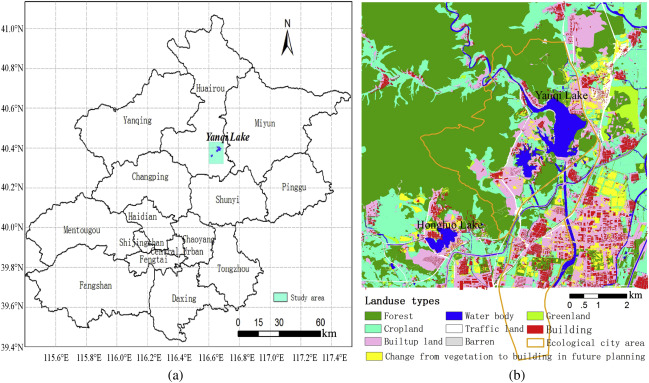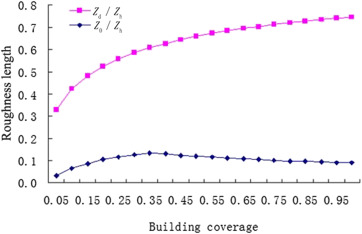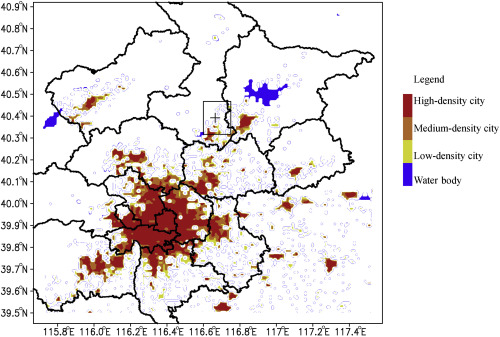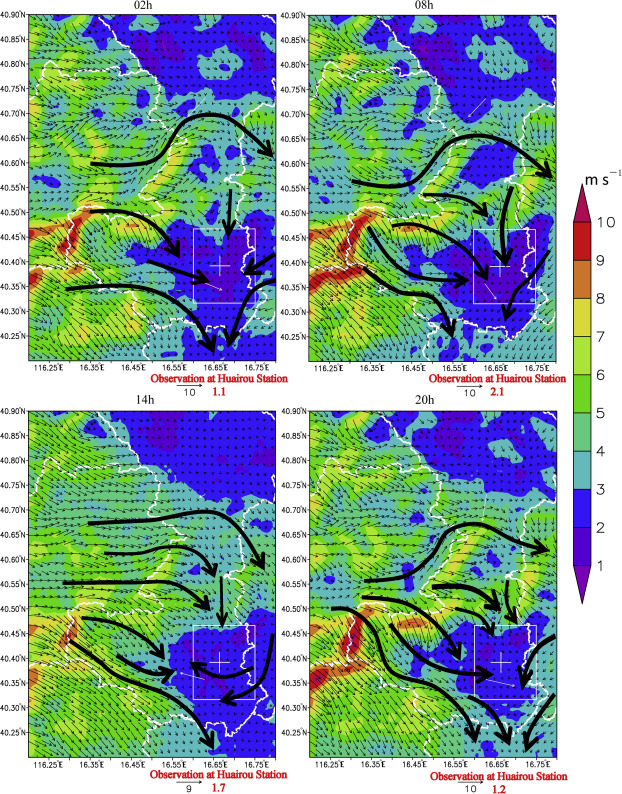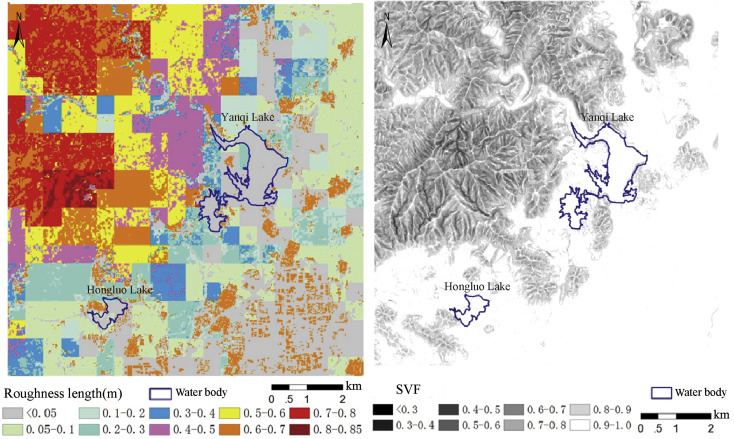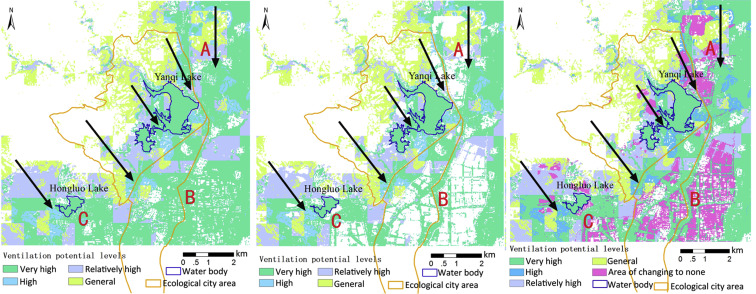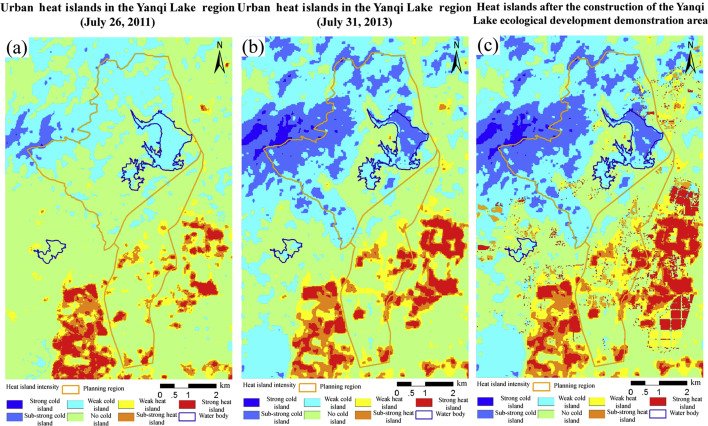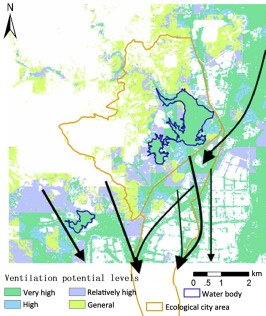Abstract
In contrast to the input perspective for evaluating planning metrics, this research takes the climatic environmental output effects as the starting point for assessing ecological city construction. Based on approaches such as observation data analysis, meteorological model simulation, and remote sensing, a set of climatic environmental performance assessment methods is developed and established. These methods mainly focus on surface ventilation assessment and urban thermal environment assessment. With the Yanqi Lake ecological development demonstration area located in Huairou district, Beijing as an example, the assessment of the local climatic environment before and after the construction are conducted, and relevant policy suggestions for urban planning and construction are presented. The results show that after development, the ventilation capacity will decrease overall and the ventilation potential index will decrease from 0.53 to 0.44. While this is not a large reduction, and is still at a favorable level, the ventilation potential in some local areas will markedly decrease. Furthermore, the thermal environment will become poorer to some extent; the urban heat island (UHI) area and intensity will increase compared with the current situation; continuous heat islands may occur in local areas; the UHI potential index of the core area will rise from 0.0878 to 0.1217 (still a favorable level). Therefore, urban surfaces should be carefully developed and arranged during planning. It is suggested that the negative impacts of large areas of urban construction on the local climatic environment in the Yanqi Lake could be mitigated by 1) strengthening the airflow by introducing fresh, cold, northwesterly air via constructed ventilation corridors, 2) increasing the number of ecological cold sources, particularly for water bodies and green belts to prevent the UHI in the southern region of Yanqi Lake from becoming linked with each other, and 3) considering a pre-program before sub-domain and building planning to obtain optimum building locations. Different construction standards should be developed for different ventilation potential and UHI intensity levels. For strong heat island areas, land areas should be reserved to serve as cold sources.
Keywords
Ecological city construction ; Ventilation environment ; Thermal environment ; Performance assessment ; Yanqi Lake ecological development demonstration area
1. Introduction
Urban environmental construction in China began with pollution treatment and ecological system optimization, and was followed by the comprehensive construction of ecological cities. Furthermore, knowledge of the environmental effects of urban construction has increased. Although the construction of ecological cities benefits the nation and its people, there are many activities that are implemented without consideration of their environmental effects. Therefore, scientific quantification methods for evaluating ecological city construction effects have become relevant topics for academic research, policy-making, and plan implementation (Zhang and Zhang, 2013 ). However, current evaluation methods conducted by urban planning departments usually derive from the planning indices of the relevant ministries and commissions, and mainly evaluate the construction and implementation from the perspective of the inputs. Meanwhile, evaluating the output effects of ecological city construction is still being tentatively explored. Whether the added input obtains the corresponding environmental effects directly reflects the success of ecological city construction. Furthermore, when an ecological city enters the implementation phase, the focus is on the environmental effects of the output in terms of investment. Numerous problems related to the urban climate and atmospheric environment have become increasingly apparent, such as the heat island effect and air pollution. To minimize negative impacts on the local atmospheric environment, various forms of ecological city planning and construction focus on rational, scientific methods. As a result, it is required that effective evaluation of the local climate environmental performance be conducted after the implementation of planning schemes. Based on these evaluations, we believe that the local climate environmental effects caused by ecological city construction will be evident. This information will aid the understanding of governments, scientific research institutions, and the general public. The outcome of this research will be a technical tool to support planners for adjusting and optimizing ecological city planning schemes and enhancing input–output efficiency.
Urban ventilation refers to the manner in which rivers, lakes, valleys, and other natural ventilation channels and artificially established urban ventilation channels are used to guide urban airflow and improve urban air quality (Lei et al., 2011 ). It is of great importance to enhance the self-purification capacity of the urban atmospheric environment, as this relieves the urban heat island (UHI) effect and improves the comfort of urban residents; it is also currently the main environmental element in urban architectural design and urban planning. At present, urban ventilation research is still at a nascent stage. The research methods mainly include field tests, wind tunnel tests, and numerical simulation, and the research results are mainly expressed through wind field values and visualizations (Peng, 2008 , Zhang et al., 2004 and Birgit et al., 2007 ). There have been numerous overseas and domestic studies on monomer building ventilation, small-scale group building ventilation, and urban street valley ventilation (Morhmald and Shinsuke, 2008 , Zhao et al., 2009 and Li et al., 2012 ), but urban ventilation evaluation is still at a preliminary stage. Therefore, it is necessary to establish a ventilation assessment method according to local conditions, and assess the ventilation environment before and after the construction of ecological cities to evaluate the effects of urban planning on the improvement of urban air quality and relief from UHI effects.
The UHI is a climatic phenomenon in which the temperature within an urban area is higher than that on the outskirts. It affects the material and energy flows in an urban ecological system, changes the structure and functions of the urban ecological system, gives rise to a series of ecological effects, and can even affect the health of urban residents. Therefore, for the assessment of the effects of ecological city constructions on climate, it is very important to assess the urban thermal environment, which is dominated by the UHI effect. There have been a number of studies on the UHI using meteorological data analysis, remote sensing monitoring, and numerical simulation methods. Using 30-year air temperature data observed at five meteorological stations (three on the outskirts and two in the urban area) in Toronto, Tanzina and William (2012) researched the UHI using the time series analysis method. Using Thematic Mapper (TM) remote sensing data, Qin et al. (2001) conducted surface temperature inversion using a mono-window algorithm and analyzed the UHI effect at the Israel–Egypt border. Using a monolayer urban canopy model (UCM) of the Weather Research Forecast (WRF) model coupling, Li et al. (2013) researched the UHI in Singapore.
In contrast to the input perspective for evaluating planning metrics, this paper takes the climatic environmental output effects as a starting point for assessing ecological city construction. A set of climatic environmental performance assessment methods has been established for pre-evaluating the ventilation and thermal environment after ecological city construction. Furthermore, as a pilot study, the methods have been applied in the ecological development demonstration area of the Yanqi Lake in the Huairou district. Based on the results, relevant construction policies are recommended. These, above all, will assist in the accumulation of practical experience for amending and perfecting the evaluation methods.
2. Research content
2.1. Assessment content
2.1.1. Ventilation assessment
The ventilation environment of a city depends on the surface roughness, surrounding area openness, and underlying surface ventilation potential, and it is also affected by the background wind environment. Therefore, this study analyzed the surface ventilation potential and background wind environment, and based on the planned land functions, comprehensively assessed the ventilation environment after the construction of an ecological city.
2.1.2. Urban thermal environment assessment
Since the number of meteorological stations is currently limited, satellite remote sensing technology was used to obtain the current spatial distribution of heat islands. The heat island distribution after construction was forecast to determine heat island changes due to construction.
2.2. Brief introduction to the research area
The Yanqi Lake ecological development demonstration area, located in the southeast of the Huairou district, is a key industrial drive demonstration project in Beijing, and will be constructed as a high-end service, high-quality cultural and leisure area (Fig. 1 a). Land use types are indicated in Fig. 1 b, where yellow shading represents a change in land type from vegetation to buildings under future planning. The core area, which is called the ecological city area in Fig. 1 b, covers 21 km2 , and the supporting town area covers 10 km2 . Compared with the current land use, the public greenbelt and protective greenbelt area will increase around the Yanqi Lake, the decentralized residential and industrial land of the supporting towns in the south will be adjusted and arranged in a centralized manner, and the industrial and residential land area will be increased.
|
|
|
Fig. 1. Schematic diagram of (a) location of the Yanqi Lake ecological development demonstration area, Huairou district, Beijing, and (b) its land utilization situation and future change diagram. |
3. Methods and data
The study focused on the assessment of climate environmental changes before and after the ecological city construction. By integrating the existing technologies, a set of methods was established for assessing the effects of construction on the ventilation and thermal environment of the ecological city.
3.1. Surface ventilation assessment
Based on the analysis of the local background wind environment, a qualitative evaluation of the ventilation potential before and after the construction was conducted. Then, using the established ventilation potential index (VPI), a quantitative assessment was performed.
3.1.1. Estimation of surface ventilation potential
The surface ventilation potential is determined by ground coverage of buildings, surface roughness of natural vegetation, and access to the surrounding open area. The building coverage is the main negative factor that reduces air circulation, and the natural vegetation and access to the surrounding open area are the main positive factors that increase airflow (HKPD, 2009 ). The surface roughness and open area can be quantitatively estimated by the aerodynamic roughness length and sky openness, respectively.
3.1.1.1. Calculation of surface roughness
Surface roughness is quantitatively expressed by the dynamic roughness length, Z0 . It is commonly calculated using the meteorological and morphological methods. Considering the data availability, Z0 in this study was calculated with the morphological method, using remote sensing and geographic information data. As the ecological city area contains large areas of vegetation and town, Z0 of the underlying surfaces of the vegetation and town areas should be estimated.
In this study, Z0 for the vegetation area was estimated based on the simple morphological method of Raupach (1994) .
Formula expression:
|
|
( 1) |
|
|
( 2) |
|
|
( 3) |
|
|
( 4) |
|
|
( 5) |
Where is zero plane displacement height (m); is dynamic roughness length (m), is roughness element height (m); is normalized zero plane displacement height; is normalized roughness length; is windward area ratio of roughness element on unit surface area; is canopy area index of roughness element on unit surface area (for isotropy roughness element, ); is roughness layer influence function; is surface resistance coefficient; is resistance coefficient of roughness element; is shading coefficient of roughness element; is canopy width of roughness element; is an empirical coefficient; is wind speed; is friction velocity (or shearing velocity); and is the Karman constant (=0.4).
The seven model parameters, , (or ), α, , (or ), , and , were determined according to Jasinski et al. (2005) . The vegetation canopy area index was calculated based on Borak et al. (2005) and Yang et al. (2011) through the method defined by Zeng et al. (2001) :
|
|
( 6) |
|
|
( 7) |
Where is green leaf area index, namely, the common leaf area index; is withered leaf area index, including tree stem area index and withered and fallen leaf area index; is the green leaf area index of month n ; is the monthly minimum withered leaf area index of different vegetation coverage types; and is the monthly falling rate of withered leaves. The and α of different land use types in the research area were obtained according to the and α parameter tables for different MODIS IGBP vegetation cover types by Zeng et al. (2001) (Fig. 1 b). The green leaf area index was directly obtained from the leaf area index via remote sensing inversion. In this study, the leaf area index was inverted from a Landsat-TM remote sensing image obtained during clear, summer conditions.
The estimation of vegetation height, Zh , includes forest and plain farmland areas; the former changes slightly with the season, but for the latter, as the phenological phase changes, plant height changes relatively rapidly. In the study area, farmland in the plain area contains mainly wheat and corn, and the vegetation height is generally constant across the seasons; therefore, it can be obtained from the abundant measured data or literature. The forest vegetation height can be obtained via satellite radar inversion through the methods of Zhou et al. (2011) . In the present study, we used forest vegetation height data with a 1-km spatial resolution inverted by the American satellite GLAS, and the corrections were performed based on the average height of broad-leaved forest, coniferous forest, bush wood, and other vegetation types determined by Cui et al. (2000) and Song (2010) .
For the urban area, Z0 was estimated according to the urban morphological model established by Grimmond (1999) :
|
|
( 8) |
|
|
( 9) |
|
|
( 10) |
Where the different parameters are subjected to the vegetation morphological model above. The term is the windward area ratio of urban buildings per unit surface area. Also called the building sectional area index, is a complex variable involving building form; it is closely related to the urban building coverage, . In Grimmond (1999) , the corresponding building coverage of the peak value of the normalized roughness length in the urban area simulated by multiple morphological methods is 0.3–0.4, and approximately 0.35 in most cases. According to Equations (9) , (10) and (11) , and using 0.35 as the peak value of urban building coverage in the present study, the relationship between building sectional area index and urban building coverage was back-deduced, and the obtained expression = 0.8 is relatively accurate. Thus, the change curve of the normalized roughness length, , and the normalized zero plane displacement height, , against building coverage, , can be simulated (refer to Fig. 2 ). The normalized roughness length reaches its peak value when = 0.35. This is consistent with the dynamic roughness length in urban areas (Grimmond, 1999 ).
|
|
|
Fig. 2. Changes of roughness in an urban area with building coverage. |
3.1.1.2. Calculation of sky openness
Sky openness is also called the sky view factor (SVF). It is a numerical value describing the 3D urban form; it reflects the different geometrical forms of street channels in a city, affects the surface energy balance relationship, changes local air circulation, acts as a comprehensive index for urban planning of street, community, and other local features, and serves as a reference for the scientific planning of a city. More details can be found in Oke (1981) . There are multiple methods for the acquisition of SVF, including the vector calculation and grid calculation models. Gál et al. (2008) compared the vector calculation and grid calculation models, and noted that the grid calculation model is more suitable for the rapid calculation of urban surface openness from large-scale and large-volume data. In this study, the grid calculation model based on the high-resolution digital elevation model (DEM) of Zakšek et al. (2011) was adopted to estimate the SVF. Fig. 3 shows the calculation principle. The sky visual solid angle and the normalized sky visual solid angle (i.e., the sky openness, SVF), can be expressed by the following formula
|
|
( 11) |
|
|
( 12) |
Where Ω is sky visual solid angle; γ is influence of terrain height angle in azimuth angle i ; n is number of calculated azimuth angles; and SVF is normalized sky visual solid angle, namely sky openness. In this article, SVF was estimated using a digital elevation grid image of Beijing with a 5-m spatial resolution. The azimuth angle number was n = 36 and the radius of influence was 20-grid (namely, 20 × 5 m = 100 m).
|
|
|
Fig. 3. Numerical simulation scope of the WRF model and updated land use conditions. |
3.1.2. Background wind field analysis
Wind direction and speed in the research area and its surroundings were obtained from meteorological stations. Statistical analysis was performed on the prevailing wind and mountain-valley breeze data. Land utilization data of the ecological city was updated in the numerical prediction model, and numerical simulation was performed for the background wind field. The statistical analysis and numerical simulation results show that the background wind environment in the assessment area was, on the whole, fairly accurately represented.
- Prevailing wind. The annual and seasonal prevailing winds were determined based on the observational data of wind direction and wind speed from the Huairou state meteorological station (30-year data from the year 1981 to 2010) and 16 automatic meteorological stations (2009–2013) in the Huairou district.
- Mountain breeze and valley breeze. The predominant wind direction and start and end times of the mountain and valley breezes were determined using the data from the automatic meteorological station. The mountainous area presents a northeast-southwest direction. Wind with a northwest direction is considered a mountain breeze, and wind with a southeast direction is a valley breeze. The wind direction (eight-direction calculation method) with the maximum frequency during a certain period is considered the prevailing wind direction, i.e., the period during which more than half the wind direction was southeast (northwest) was regarded as a valley (mountain) breeze period.
- Wind speed. The annual wind speed was determined based on the monthly speed from 1981 to 2010, as recorded by the Huairou state-level meteorological station. The spatial distribution of wind speed was obtained through spatial interpolation of the observational data from the automatic meteorological stations.
A 1 km × 1 km spatial resolution wind field covering a typical year and typical weather conditions in Beijing was simulated using the WRF model via multi-nesting, and the wind field and characteristics of the background wind field near the ground were analyzed.
- Model parameter setting. After the grid points were created, the urban land use data for Beijing in 2012 were input to the WRF model (the urban land is divided into high-density urban land, medium-density urban land, and low-density urban land based on the impervious surface percentage, and they correspond to Types 31, 32, and 33, respectively, in the WRF model (refer to Fig. 3 ). A 4-layer area nest of 27 km, 9 km, 3 km, and 1 km was adopted. The innermost nest area covers all of Beijing, and the physical process parameterization scheme, which has been investigated and widely used in Beijing, was selected. An urban canopy model was used to perform the wind field numerical simulation with 1-km resolution.
- Wind field simulation in a typical weather case. One case is selected as mild wind pollution condition, that means low observed average wind speed and hazy weather; the other case is selected as strong wind diffusion condition, that means high observed average wind speed and no hazy weather; the third case is selected as ordinary weather condition, that means the observed wind speed is close to the monthly average wind speed and no hazy weather occurs.
- Average wind field simulation. In order to analyze the stable background wind environment in the Yanqi Lake region, 10 m-high average wind fields for half a month in the winter of 2013 were simulated using the WRF model. Furthermore, the simulation results in the southeast of Huairou were compared with the average wind direction and speed during the simulation period recorded at the Huairou state-level meteorological station (Fig. 4 ).
|
|
|
Fig. 4. The simulated 10 m-high wind field at typical hours averaged from January 2 to 16, 2013 for Huairou district (the white arrows and red text indicate the average wind direction and average wind speed recorded by the Huairou state-level meteorological station at the corresponding hours). |
3.1.3. Ventilation potential index
The ventilation potential index (VPI) is a quantitative index used to compare the ventilation potential at different times and areas:
|
|
( 13) |
Where m is ventilation potential grade, i is serial number of ventilation potential grade from none to high, n is grade of ventilation potential, wi is weight at grade i , and Pi is the percentage at grade i . Generally, the value of VPI is between 0 and 1. Larger values indicate higher ventilation potential. Here m = 5 and n = 4.
3.2. Urban thermal environment assessment
We used UHI intensity to assess the thermal environment. Based on a satellite remote sensing method which compared spatial changes in the heat island intensity before and after construction of the ecological city, the thermal environment was qualitatively evaluated, the urban heat island potential index (UHPI) was established, and the thermal environment after construction of the ecological city was quantitatively assessed.
3.2.1. Surface temperature inversion
The surface temperature (120-m resolution) inversion was based on the methods of Jimenez-Munoz and Sobrino (2003) and Xu and Liu (2013) using Landsat-TM high-resolution remote sensing data.
The 2011 land use is considered to be the current land utilization and the land use in the detailed plan in Fig. 1 b regarded as the planned land use. The surface temperature of both is determined using the above method.
3.2.2. Estimation and grading of UHI intensity
The average surface temperature in the farmland area is taken as the outskirts temperature, and its difference from the surface temperature in all other areas is defined as the UHI intensity. The specific calculation is
|
|
( 14) |
Where UHIIi is UHI intensity; Ti is temperature of pixel i ; Tcrop is temperature of a pixel in the farmland area; and n is total number of pixels in the farmland area. It is evident that the key point in the calculation of the heat island intensity is the selection of the outskirts farmland. Considering the general characteristics of the outskirts farmland, and the terrain and underlying surface features in the study area, the areas that met the following conditions were regarded as outskirts farmland in this study:
- Plain (the altitude difference between city and plain is less than 50 m).
- Farmland type in the outskirts.
- Vegetation coverage ≥80%.
- Imperviousness coverage ≤20%.
The imperviousness coverage and vegetation coverage were determined using the linear spectrum mixed decomposition method. The vegetation coverage was mainly estimated using the V-I-S-W model (Ridd, 1995 ):
|
|
( 15) |
The impervious stratum may be indicated by the sum of the proportion of low albedo end members and high albedo end members (Wu and Murry, 2003 ):
|
|
( 16) |
The key point in the above mentioned method is the selection of the end member (pure pixel). The minimum noise fraction (MNF) transformation was performed for the Landsat-TM image, and the pure pixel was selected based on the first four MNF wave bands (89% of the information amount). The impervious surface coverage and vegetation coverage estimations were performed based on this method.
After the outskirts farmland was determined, the UHI intensity was calculated and divided according to the categories in Table 1 (Ye et al., 2011 ).
| Category | Daily range | Monthly and quarterly range | Grade |
|---|---|---|---|
| 1 | ≤−7.0 | ≤−5.0 | Strong cold island |
| 2 | −7.0 to −5.0 | −5.0 to −3.0 | Relatively strong cold island |
| 3 | −5.0 to −3.0 | −3.0 to −1.0 | Weak cold island |
| 4 | −3.0 to 3.0 | −1.0 to 1.0 | No heat island |
| 5 | 3.0 to 5.0 | 1.0 to 3.0 | Weak heat island |
| 6 | 5.0 to 7.0 | 3.0 to 5.0 | Relatively heat island |
| 7 | >7.0 | >5.0 | Strong heat island |
3.2.3. UHPI
The definition of UHPI is
|
|
( 17) |
Where UHPI is urban heat island potential index; m is heat island intensity grade; n is grade of temperature difference between the urban area and the outskirts; i is serial number of n ; vi is weight at grade i ; and qi is the percentage of grade i . Generally, the UHPI value is between 0 and 1. Larger values indicate more severe heat island effects. Here, m = 7 and n = 3.
3.3. Essential data
The essential data used in this study include urban planning, remote sensing, geographic information system, and meteorological data. The specific data, sources, and applications are shown in Table 2 .
| Data category | Data name | Data source | Main application |
|---|---|---|---|
| Urban planning data | Position sketch map, land utilization functional status and planning map for ecological development demonstration area of the Yanqi Lake | Beijing Institute of Architectural Design | Providing basic land use data for ventilation evaluation and thermal evaluation |
| Remote sensing and geographic information data | Urban land data in Beijing 2009, urban land is divided into low density, medium density, and high density according to percentage of impervious area | Landsat-TM satellite data retrieval | Updating the urban land use data of original 30-s horizontal resolution global data (1992–1993) from United States Geological Survey (USGS) in WRF model for conducting simulation analysis of the background wind environment value |
| Landsat-TM5 data on July 26, 2011 and Landsat-TM 30-m resolution remote sensing data on July 31, 2013 | Free access to the Internet, https://lpdaac.usgs.gov/data_access/data_pool | Land use type extraction and urban heat island estimate | |
| Rapideye 5-m resolution remote sensing image data on September 19, 2011 | Purchased from companies | Building information extraction in plain areas of Beijing | |
| 1:2000 building information within Beijing sixth circle expressway in 2009 | Beijing Institute of Surveying and Mapping | Extracting information on sky openness, building density, and building height | |
| Meteorological data | Averaged wind speed and wind direction data compiled over 30 years at national basic weather station of Huairou, Beijing (1981–2010) by Beijing Meteorological Bureau | Beijing Meteorological Service | Background wind environment analysis |
| The observed wind direction and wind speed data by minute and by hour during 2009–2013 in 16 automatic meteorological stations of Huairou | Beijing Meteorological Service | Environmental statistical analysis of background wind in ecological city as well as calculation of gridding emissions of main atmospheric pollutants | |
| Global analysis data in January 2013 (Final Operational Global Analysis, FNL) | National Centers for Environmental Prediction (NCEP) | Meteorological initial field and boundary conditions for generating WRF mode |
4. Effect of the future construction on climate
4.1. Ventilation assessment
4.1.1. Assessment of surface ventilation potential
Fig. 5 (left) shows the SVFs of the Yanqi Lake region at a spatial resolution of 100 m. It is obvious that the SVFs of the mountainous areas in the western and northern parts of the Yanqi Lake are lower than those of the plains, which are generally below 0.8. Most SVFs in the built-up regions of the plains are 0.5–0.8, and those of the remainder of the plains are generally above 0.9. The Landsat-TM (30-m) image for 2011 was used to estimate the leaf area index and extract the land use types. Then, the roughness length, Z0 , of the regions surrounding the Yanqi Lake was determined at a resolution of 100 m (Fig. 5 , right). The roughness lengths of the surface in the northwestern mountainous areas are relatively long, generally above 0.5 m (above 0.8 m in some areas). In the built-up regions, the values are 0.6–0.7 m, and in the non-built-up areas are generally less than 0.3 m.
|
|
|
Fig. 5. Roughness length (left) and sky view factor (right) of the Yanqi Lake ecological development demonstration area and surrounding regions. |
Based on the calculated roughness length and sky view factor, we calculated the surface ventilation potential in the Yanqi Lake region, and graded the calculation results based on the values in Table 3 . Due to buildings in the mountainous areas, we did not consider, or grade, the ventilation potential in these areas. The ventilation potential after construction of the ecological city was determined based on roughness length and sky view factor. The distribution of the ventilation potential before and after construction shows that the overall ventilation potential of the ecological city will decrease due to the construction of groups of building over large areas. Therefore, it is necessary to construct ventilation corridors to guarantee ventilation of the environment.
| Type | Grade I | Grade II | Grade III | Grade IV | Grade V |
|---|---|---|---|---|---|
| Roughness length | >0.5 | 0.1–0.5 | ≤0.1 | 0.1–0.5 | ≤0.1 |
| Sky view factor | / | 0.75–0.90 | 0.75–0.90 | ≥0.9 | ≥0.9 |
| Meaning | None | General | Relatively high | High | Very high |
4.1.2. Background wind field analysis
Northwest and southeast winds prevail in the study area, and there are obvious mountain and valley winds. The durations of mountain and valley winds within a day in each season are different due to the different durations of sunshine. In winter, the duration of mountain winds is the longest; while in summer, the duration of valley winds is the longest.
In winter, when the diffusion condition is relatively good, the area experiences prevailing northerly winds (although southerly winds occur during short periods of polluted weather). In summer, when the diffusion condition is relatively good, the area mainly experiences southerly wind (although southerly wind with relatively low wind velocity also occurs during short periods of polluted weather). A mountain-valley breeze prevails under ordinary weather. The ecological city is located in the region where the plains and mountains meet, and the complicated terrain causes uneven wind velocity distribution around the ecological city, i.e., the wind velocity in the plains is lower than that in the mountainous area in the northwest.
4.1.3. Comprehensive assessment before and after construction
Fig. 6 shows the ventilation environment before and after the construction of the ecological city, as well as the difference between the two, based on the ventilation potential and background wind. Fig. 6 (right) shows that the ventilation potentials of three regions, location A in the northeast, the related town B in the south, and location C in front of the mountains around the Hongluo Lake, will decrease slightly. Location A is in the plains area, where northerly and northwesterly winds prevail. Therefore, the construction of many groups of building will not only influence the ventilation environment, but may prevent northern airflow from entering the core area of the Yanqi Lake, town B, and location C around the Hongluo Lake; thus deteriorating the overall ventilation in the ecological city. However, in town B, the regions with very high ventilation potential are significantly reduced, while the increase in the number of buildings in the core area of the Yanqi Lake is relatively small; after the construction of the ecological city, northwesterly airflow can also arrive at this small town. Therefore, ventilation corridors in the construction area can be created to effectively reduce the influence on regions where the reserved ventilation potential is relatively high; thus, to some extent relieving the negative influence of the construction on the ventilation environment of location B. In location C around the Hongluo Lake, there are large areas with very high ventilation potential before the construction of the ecological city. The construction will result in a large number of built-up regions in the southeastern part of the Hongluo Lake, which will influence the ventilation potential. In particular, the buildings on the south shore are located along northwesterly wind channels and the lake-land breeze path, which may block their main airflow.
|
|
|
Fig. 6. The ventilation environment before (left) and after (middle) implementing the ecological city planning scheme of Yanqi Lake in Huairou, Beijing, and the difference between the two (right) (Black arrows illustrate the predominant wind directions). |
The ventilation potentials before and after the construction of the ecological city area were graded according to the VPI (see Table 4 for the detailed grading). The results show that at present the VPI is 0.5345, and that the VPI after construction will be 0.4375. Although the reduction in ventilation potential is only slight after the construction, the ventilation potential is grade 3 (general), which is relatively good.
| Grade | Ventilation potential index (VPI) | Assessment grade |
|---|---|---|
| 1 | 0–0.1 | Poor |
| 2 | 0.1–0.3 | Relatively poor |
| 3 | 0.3–0.7 | General |
| 4 | 0.7–0.9 | Good |
| 5 | 0.9–1.0 | Very good |
4.2. Thermal environment assessment
4.2.1. Heat island monitoring and prediction after construction
According to the standards given in Table 1 , the UHI intensity in different years is shown in Fig. 7 . The results indicate that the heat island effect in 2013 was slightly stronger than that in 2011. In particular, both heat island area and intensity increased slightly in the Yanqi industrial grouping region in the southeastern part of the core area. However, the UHIs in 2011 and 2013 were, on the whole, scattered. Compared with the current situation, both the heat island area and intensity will increase slightly after the construction. Furthermore, the two largest heat island regions, the northern part of the Huairou district and the Yanqi industrial grouping region, are likely to become linked together. Therefore, close attention needs to be paid to the changes in the heat islands in the Yanqi residential region, especially in the middle of both the regions mentioned above. The surface should be carefully developed and arranged, the number of water bodies and green belts should be increased, and ventilation corridors should be created to prevent the UHIs in the southern region of the Yanqi Lake from becoming linked together. However, after the construction of the ecological city, the heat island area and intensity change in the core area are relatively small, and heat islands are distributed, in a scattered manner, only in some regions of new building.
|
|
|
Fig. 7. UHI monitoring and prediction of heat island intensity after construction of the Yanqi Lake ecological development demonstration area. |
4.2.2. Quantitative assessment of UHIs
Based on the standards in Table 5 , the results show that the UHPI of the core area in July 2011 and July 2013 were 0.0624 and 0.0878, respectively; placing them in the slight or none grade. Meanwhile, the UHPI predicted for heat islands after the construction is 0.1217; placing it in the general grade, which is still relatively good. However, we can imagine that in other areas, especially in the two largest heat island regions, conditions are likely to become worse.
| Grade | Urban heat island proportion index (UHPI) | Assessment grade |
|---|---|---|
| 1 | 0–0.1 | Slight or none |
| 2 | 0.1–0.3 | General |
| 3 | 0.3–0.7 | Relatively severe |
| 4 | 0.7–0.9 | Severe |
| 5 | 0.9–1.0 | Very severe |
5. Conclusions and suggestions
5.1. Effect on the climate
5.1.1. Ventilation
The VPI of the study area will decrease from the current 0.5345 to 0.4375 after the construction of the ecological city, and the ventilation capability will also weaken. However, the assessment grade of the ventilation potential will remain at the general grade, which is relatively good. It is necessary to point out that after construction the ventilation potential will markedly decrease for a relatively large area with buildings in the northeastern part of the Yanqi Lake, the related town in the southern part of the Yanqi Lake, and the area in front of the mountains around the Hongluo Lake.
5.1.2. Thermal environment
The UHPIs for July 2011, July 2013, and after the construction of the ecological city are 0.0624, 0.0878, and 0.1217, respectively. The heat island grade in 2013 changed to general from the original slight or none grade; however, the general grade is still relatively good. Furthermore, the heat scope and intensity changes in the core area of the ecological city are relatively small. It is necessary to point out that after the construction of the ecological city, both the heat island area and intensity will increase slightly as compared with the present situation, and that the two largest heat island regions, i.e., the northern part of the Huairou district and Yanqi industrial grouping region, may become linked together.
5.2. Development suggestions
5.2.1. Constructing urban ventilation corridors
The land use plan for the regions around the Yanqi Lake ecological development demonstration area shows a relatively large open space in the northwestern region of the main construction land, and multiple main roads and river channels, oriented from south to north, are also present. These river channels, main roads, and green corridors can be utilized as ventilation corridors (Matzarakis and Mayer, 1992 ) so that the fresh air generated in the open space in the northwestern region of the built-up area (cold source) and the northwesterly background wind can flow into the constructed region in the southeastern region of the ecological city to relieve the negative influence of the construction on the local weather and atmospheric quality (as shown in Fig. 8 ).
|
|
|
Fig. 8. Suggested ventilation corridors for the regions surrounding the Yanqi Lake ecological development demonstration area. |
5.2.2. Relieving UHIs
The thermal assessment shows that after construction of the ecological city both the area and intensity of the heat islands in the Yanqi industrial grouping region will increase slightly as compared with the current situation. However, the two largest heat island regions, the northern part of the Huairou district and the Yanqi industrial grouping region, may become linked together. This linking should be prevented to avoid the relatively strong heat islands developing into a single, stronger island. Furthermore, land should be reserved to serve as a cold source.
5.3. Future research
This research started by evaluating the climatic environment output effects of ecological city construction inputs. Qualitative and quantitative assessments of the local climatic environment before and after the construction of the Yanqi Lake ecological development demonstration area were performed and relevant policy suggestions were formulated. In the future, the following items will require further study:
5.3.1. Establish more comprehensive assessments
This research mainly focused on assessing the ventilation and thermal environments before and after construction of the ecological city. In the future, it will be necessary to establish more comprehensive assessments of the climatic environment covering the urban atmosphere and urban meteorological disasters.
5.3.2. Improve the assessment methods
This study utilized remote sensing, geographical information systems, meteorological numerical simulation methods, and other technologies that are relatively well developed. As technology progresses, remote sensing with higher resolution and precision, and the latest assessment methods and technologies (e.g., a 100-m resolution meteorological numerical model), will need to be employed.
5.3.3. Expand the scope of application
The Yanqi Lake ecological development demonstration area belongs to a new breed of newly-built ecological cities on the outskirts of an urban area. In the future, assessments should be made for the construction of ecological cities in central urban areas and the reconstruction of old ecological cities with improved research methods and technologies, enhancing the applicability of the evaluation methods.
5.3.4. Form relevant assessment technical specifications
Relevant research data, methods, and techniques should be extracted and summarized into technical specifications for the assessment of the effects of ecological urban construction on climate. Based on these specifications, planners can visualize the basic climate environment of the city and optimize the design before construction.
Acknowledgements
This work was sponsored by Beijing Municipal Science and Technology Project (Z131100001113026 ), the Program of the Research and Innovation Team on Urban Climate Assessment of Beijing Meteorological Bureau , Climate Change Special Foundation of China Meteorology Administration (CCSF201506 ), Science and technology project of Beijing Meteorological Bureau (BMBKJ201402002 ) and National Natural Science Foundation of China (71473146 ).
References
- Birgit et al., 2007 K. Birgit, C. Malcolm, L. Kevin; Environmental performance of a naturally ventilated city centre library; Energy Buildings, 39 (2007), pp. 792–801
- Borak et al., 2005 J.S. Borak, M.F. Jasinski, R. Crago; Time series vegetation aerodynamic roughness fields estimated from MODIS observations; Agric. For. Meteorol., 135 (1–4) (2005), pp. 252–268
- Cui et al., 2000 G.-F. Cui, K.-W. Cheng, G.-Z. Shen, et al.; Status and classification of vegetation in Labagoumen forest region in Beijing; J. Beijing For. Univ., 22 (4) (2000), pp. 46–51 (in Chinese)
- Gál et al., 2008 T. Gál, F. Lindberg, J. Unger; Comporting continues sky view factor using 3D urban raster and vector databases: comparison and application to urban climate; Theor. Appl. Climatol., 95 (1–2) (2008), pp. 111–123
- Grimmond, 1999 C.S.B. Grimmond; Aerodynamic properties of urban areas derived from analysis of surface form; J. Appl. Meteorol., 38 (1999), pp. 1262–1291
- HKPD, 2009 HKPD (Hong Kong Planning Department); Hong Kong planning standards and guidelines.CPLD49/05; (2009) Committee on Planning and Land Development (in Chinese)
- Jasinski et al., 2005 M.F. Jasinski, J. Borak, R. Crago; Bulk surface momentum parameters for satellite-derived vegetation fields; Agric. For. Meteorol., 133 (2005), pp. 55–68
- Jimenez-Munoz and Sobrino, 2003 J.C. Jimenez-Munoz, J.A. Sobrino; A generalized single channel method for retrieving land surface temperature from remote sensing data; J. Geophys. Res., 108 (D22) (2003), pp. 4688–4695
- Lei et al., 2011 X.-P. Lei, L.-B. He, C.-L. Wu; Research methods and improvement measure research progress of urban ventilation; Build. Energy Environ., 30 (1) (2011), pp. 11–17 (in Chinese)
- Li et al., 2012 L. Li, D. Wu, L.-J. Zhang, et al.; Ventilation assessment on urban-block detailed planning based on numerical simulation; Acta Sci. Circumstantiae, 32 (4) (2012), pp. 946–953 (in Chinese)
- Li et al., 2013 X.X. Li, T.Y. Koh, E. Dara, et al.; A multi-resolution ensemble study of a tropical urban environment and its interactions with the background regional atmosphere; J. Geophys. Res. Atmos., 118 (17) (2013), pp. 9804–9818
- Matzarakis and Mayer, 1992 A. Matzarakis, H. Mayer; Mapping of urban air paths for planning in Munchen; WissBer Inst. Meteorol. Klimaforsch. Univ. Karlsruhe, 16 (1992), pp. 13–22
- Morhmald and Shinsuke, 2008 B. Morhmald, K. Shinsuke; Assessment of wind ventilation performance inside a street located within a dense urban area using exceedance probability; Seisan-Kenkyu, 60 (1) (2008), pp. 5–13
- Oke, 1981 T.R. Oke; Canyon geometry and the nocturnal heat island: comparison of scale model and field observations; J. Climatol., 1 (1981), pp. 237–254
- Peng, 2008 R.-Q. Peng; Wind field numerical simulation in building environment; J. Xi Hua Univ. Nat. Sci. Ed., 27 (1) (2008), pp. 50–54 (in Chinese)
- Qin et al., 2001 Z. Qin, A. Karnieli, P. Berliner; A mono-window algorithm for retrieving land surface temperature from Landsat TM data and its application to the Israel-Egypt border region; Int. J. Remote Sens., 22 (18) (2001), pp. 3719–3746
- Raupach, 1994 M.R. Raupach; Simplified expressions for vegetation roughness length and zero-plane displacement as a function of canopy height and area index; Bound.-Layer Meteor., 71 (1994), pp. 211–216
- Ridd, 1995 M.K. Ridd; Exploring a V-I-S (vegetation-impervious surface-soil) model for urban ecosystem analysis through remote sensing: comparative anatomy for cities; Int. J. Remote Sens., 16 (2) (1995), pp. 2165–2185
- Song, 2010 X.-Y. Song; Research on structural features of main arbors of forest for conservation of water supply at the upstream of Miyun reservoir: taking Chaoguan west ditch forest farm for example; Soil Water, 4 (2010), pp. 54–57 (in Chinese)
- Tanzina and William, 2012 M. Tanzina, A.G. William; Characterization and estimation of urban heat island at Toronto: impact of the choice of rural sites; Theor. Appl. Climatol., 108 (1–2) (2012), pp. 105–117
- Wu and Murry, 2003 U.C.S. Wu, A.T. Murry; Estimating impervious surface distribution by spectral mixture analysis; Remote Sens. Environ., 84 (4) (2003), pp. 493–505
- Xu and Liu, 2013 Y.-M. Xu, Y.-H. Liu; Study on the thermal environment and its relationship with impervious surface in Beijing city using TM image; Ecol. Environ. Sci., 22 (4) (2013), pp. 639–643 (in Chinese)
- Yang et al., 2011 A.-Q. Yang, G.-Q. Sun, L.-X. Lu, et al.; Deriving aerodynamic roughness length and zero-plane displacement height from MODIS product for Eastern China; J. Meteorol. Sci., 31 (4) (2011), pp. 516–524 (in Chinese)
- Ye et al., 2011 C.-H. Ye, Y.-.H. Liu, W.-D. Liu, et al.; Research on urban surface heat environment monitoring indexes and its application; Meteorol. Sci. Technol., 39 (1) (2011), pp. 95–101 (in Chinese)
- Zakšek et al., 2011 K. Zakšek, K. Oštir, Ž. Kokalj; Sky-view factor as a relief visualization technique; Remote Sens., 3 (2011), pp. 398–415
- Zeng et al., 2001 X.-B. Zeng, M. Shaikh, Y.-J. Dai, et al.; Coupling of the common land model to the NCAR community climate model; J. Clim., 15 (2001), pp. 1832–1854
- Zhang et al., 2004 B.-Y. Zhang, J.-G. Sang, G.-C. Wu; Features and simulation of wind field of building group environment: research on wind environment simulation. Part I; Mech. Eng., 26 (3) (2004), pp. 1–9 (in Chinese)
- Zhang and Zhang, 2013 L. Zhang, Y. Zhang; Discussion of the quantitative assessment method of ecological planning performance; Environ. Sci. Manage., 38 (3) (2013), pp. 27–30 (in Chinese)
- Zhao et al., 2009 L.-H. Zhao, Z.-J. Zheng, L. Li; Discussion of the evaluation indexes of outdoor wind environment quality for the enclosed residential quarter in Guangzhou; Proceedings of the 5th International Workshop on Energy and Environment of Residential Buildings/3rd International Conference on Built Environment and Public Health, Vol. 1 & 2 (2009), pp. 1264–1270
- Zhou et al., 2011 Z.-Q. Zhou, C.-R. Yue, T.-S. Xu, et al.; Review on forest height estimation using remote sensing; Mod. Agric. Sci. Technol., 2 (2011), pp. 198–199 (in Chinese)
Document information
Published on 15/05/17
Submitted on 15/05/17
Licence: Other
Share this document
Keywords
claim authorship
Are you one of the authors of this document?
